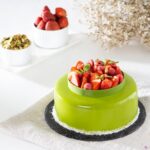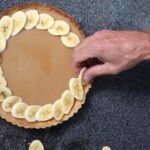Receiving a beautifully decorated cake is always a joyous occasion. The intricate details, vibrant colors, and delicious flavors make it the centerpiece of any celebration. However, all too often, the excitement soon fades when the cake starts to deteriorate in taste and appearance. That’s where proper cake storage becomes crucial. In this article, we will explore how long a decorated cake can stay in the fridge and why refrigeration is essential for maintaining its freshness.
Proper storage is paramount to keep a decorated cake looking and tasting its best. We’ve all experienced the disappointment of a dry or stale piece of cake with wilted decorations. By understanding how refrigeration impacts cake preservation, you can ensure that your masterpiece remains as delectable as when you first received it.
Refrigeration plays a vital role in slowing down bacterial growth and extending the shelf life of cakes. It creates an environment that inhibits the growth of harmful microorganisms, helping your cake stay safe to consume for longer periods. Additionally, cooler temperatures help delicate decorations retain their shape and color, preserving the visual appeal of your masterpiece.
So, how long can you actually keep a decorated cake in the fridge? Well, that depends on several factors such as frosting type and structural stability. In the following sections, we’ll delve into these considerations and provide you with guidelines on ideal storage durations for different types of cakes. By adhering to these recommendations, you can ensure optimal taste and quality when indulging in your delectable creation.
Why Refrigeration is Essential for Decorated Cakes
Refrigeration is an essential factor in preserving the freshness and quality of decorated cakes. As beautiful as a cake may be, it is equally important to maintain its taste and appearance for as long as possible. This section will explain why refrigeration is crucial for decorated cakes and highlight the significance of a cool environment for delicate decorations.
One of the primary reasons why refrigeration is essential for decorated cakes is because it helps to slow down the growth of bacteria. Cakes can provide an ideal breeding ground for harmful microorganisms if they are not stored properly. By keeping a cake in the fridge, you create a cool environment that inhibits bacterial growth and extends the cake’s shelf life.
In addition to preserving the cake’s freshness, refrigeration also plays a key role in maintaining delicate decorations. Many cakes are adorned with intricate designs made from frosting or fondant, which can easily melt or become misshapen at room temperature. Placing the cake in the refrigerator helps to firm up these decorations and keeps them intact.
To ensure successful refrigeration of decorated cakes, there are certain factors that need to be considered. The type of frosting used is an important aspect to take into account when determining how long a cake can stay in the fridge. Buttercream frostings typically have a shorter storage duration compared to fondant or ganache due to their higher moisture content.
Additionally, the structural stability of the cake should be considered, especially when dealing with multi-tiered creations or fragile decorations. It is crucial to assess whether refrigeration may cause any structural damage that could compromise the overall appearance of the cake.
Overall, refrigeration is essential for decorated cakes because it helps prevent bacterial growth and preserves delicate decorations. By storing cakes in cool temperatures, you can extend their shelf life without compromising their taste or visual appeal. However, it is important to consider factors such as frosting type and structural stability before refrigerating a decorated cake to ensure optimal results.
Factors to Consider Before Refrigerating a Decorated Cake
Before refrigerating a decorated cake, there are several factors that need to be considered to ensure optimal storage and preservation. These factors include the type of frosting used and the cake’s structural stability.
The type of frosting plays a crucial role in determining how long a decorated cake can stay in the fridge. Buttercream and cream cheese frostings have a shorter shelf life and should ideally be consumed within two to three days.
On the other hand, fondant or ganache-covered cakes can last for up to a week if stored properly. It is important to note that these time frames are general guidelines, and it is always best to use your judgment by considering the specific ingredients used in your frosting recipe.
In addition to the type of frosting, you should also consider the cake’s structural stability before refrigerating it. If your cake features delicate or fragile decorations, such as sugar flowers or intricate piping work, it may not withstand the cold temperatures of the refrigerator well. In such cases, it is advisable to remove any fragile decorations before refrigerating the cake and apply them again just before serving.
By taking these factors into account, you can make an informed decision about how long you can store your decorated cake in the fridge while ensuring its taste, quality, and appearance remain intact. Remember that different cakes may have varying storage durations based on their specific characteristics, so it is always best to consult with your baker or recipe instructions for more accurate guidance.
The Ideal Storage Duration for Decorated Cakes in the Fridge
Refrigeration plays a crucial role in extending the shelf life of decorated cakes and maintaining their freshness and appearance. While each cake is unique, there are general guidelines on how long a decorated cake can typically stay in the fridge before its quality starts to decline. It’s important to consider various factors when determining the ideal storage duration for a decorated cake.
- Type of Frosting: The type of frosting used on the cake can affect its storage duration. Buttercream and cream cheese frostings, for example, contain perishable ingredients and should be kept refrigerated.
These types of frostings usually allow the cake to stay fresh in the fridge for about 3-4 days. On the other hand, cakes with fondant or royal icing can be stored at room temperature as these icings form a protective barrier that helps preserve freshness. - Structural Stability: Another factor to consider is the structural stability of the cake, especially if it has multiple tiers or delicate decorations. Cakes with buttercream or cream cheese frosting may need additional support rods or dowels inserted into the layers to maintain their stability during refrigeration. Properly securing any fragile decorations is also crucial to prevent them from shifting or breaking in the cold environment.
- Storage Duration: Generally, a decorated cake can stay refrigerated for up to 5-7 days without compromising its taste and quality. It’s best to consume the cake within this time frame for optimal enjoyment. Beyond this period, there is a risk of dryness and loss of flavor.
To ensure your decorated cake stays fresh throughout its storage duration, consider these tips:
- Place the cake on a sturdy plate or cardboard base before covering it with plastic wrap to prevent moisture loss.
- Avoid directly storing highly fragrant foods near the cake as it can absorb their odors.
- If you need to freeze portions of the decorated cake, ensure they are well-wrapped in plastic wrap and placed in an airtight container to prevent freezer burn.
By following these guidelines, you can make the most of your decorated cake’s storage duration in the fridge and enjoy its delectable taste and appearance for as long as possible.
Common Mistakes to Avoid When Refrigerating a Decorated Cake
Refrigerating a decorated cake is an essential step in ensuring its freshness and maintaining its appearance. However, there are several common mistakes that people make when refrigerating a decorated cake that can affect its texture, taste, and overall quality. By being aware of these mistakes and taking the necessary precautions, you can successfully store your cake in the fridge without compromising its deliciousness.
One common mistake to avoid is improper covering of the cake. When placing a decorated cake in the fridge, it is important to cover it properly to prevent it from drying out or absorbing unwanted odors.
Many people make the mistake of using plastic wrap directly on the frosting, which can cause condensation and result in a soggy texture when removed. Instead, it is recommended to use toothpicks or skewers to create a tent with plastic wrap over the cake, allowing for proper airflow while still maintaining coverage.
Another mistake that people often make is storing a cake with perishable fillings or ingredients for too long. While refrigeration helps extend the shelf life of a decorated cake, certain fillings like fresh fruit or dairy-based creams may not last as long as the cake itself. It is important to consider these factors before refrigerating your cake and consume it within an appropriate timeframe to ensure optimal taste and quality.
Lastly, some individuals overlook the importance of temperature control when refrigerating their cakes. It is crucial to set your refrigerator at an appropriate temperature range (usually between 34-38°F or 1-3°C) to slow down bacterial growth effectively. A higher temperature may result in faster spoilage of the cake, while storing it at colder temperatures may cause the frosting to become hard and lose its smoothness.
To avoid these common mistakes when refrigerating a decorated cake:
- Properly cover the cake with plastic wrap using toothpicks or skewers.
- Consume cakes with perishable fillings within an appropriate timeframe.
- Set your refrigerator at the recommended temperature range for optimal storage.
By following these tips, you can ensure that your decorated cake stays fresh and delicious for as long as possible.
Properly Preparing a Decorated Cake for Refrigeration
When it comes to properly preparing a decorated cake for refrigeration, there are a few important steps to follow. By taking these necessary precautions, you can ensure that your cake remains fresh and visually appealing during its time in the fridge.
Firstly, before placing the cake in the refrigerator, it is essential to remove any excess decorations that may become compromised due to moisture or condensation. Delicate decorations such as gum paste flowers or edible sugar pearls are particularly susceptible to damage when exposed to the cold temperature of the fridge. By removing these decorations and storing them separately, you can preserve their integrity and prevent them from becoming soggy or losing their shape.
Additionally, it is crucial to cover the cake appropriately before refrigerating it. This will help protect it from absorbing unwanted odors from other foods in the fridge and prevent excessive drying out. You can use plastic wrap or airtight containers specifically designed for cakes to create a seal around the cake. Make sure that the covering is secure but not too tight, as overly tight wrapping may cause smudging of delicate designs or icing.
Finally, consider the type of cake being refrigerated and choose an appropriate storage technique accordingly. For buttercream or cream cheese frosted cakes, it is advisable to place toothpicks on top of the cake and lay plastic wrap over them to create a tent-like structure so that it does not come into direct contact with the frosting.
On the other hand, fondant-covered cakes should be loosely covered with plastic wrap or stored in a large container with enough room for air circulation.
Properly preparing your decorated cake for refrigeration ensures that you can enjoy its freshness and aesthetic appeal for an extended period. By following these steps, you can maintain both taste and visual presentation without compromising on quality.
| Preparation Steps | Description |
|---|---|
| Remove excess decorations | Take off delicate or moisture-sensitive decorations to prevent damage during refrigeration. |
| Cover the cake appropriately | Use plastic wrap or an airtight container to protect the cake from absorbing odors and excessive drying. |
| Consider cake type | Choose a suitable storage technique based on the type of frosting or covering, such as using toothpicks for buttercream and loosely wrapping fondant cakes. |
Alternative Storage Solutions for Extended Cake Shelf Life
When it comes to extending the shelf life of a decorated cake, refrigeration is not the only option. There are alternative storage solutions that can help keep your cake fresh and delicious for longer periods of time. These methods include freezing and vacuum sealing.
Freezing
Freezing is an excellent way to preserve a decorated cake if you know you won’t be able to consume it within a few days. Freezing helps to slow down the aging process and prevents the growth of bacteria, ensuring that your cake stays fresh and moist.
To freeze a decorated cake, it’s important to prepare it properly beforehand. Remove any excess decorations that may become damaged during freezing. Wrap the cake tightly in plastic wrap or place it in an airtight container before placing it in the freezer. It’s also a good idea to label the container with the date of freezing, so you can keep track of how long the cake has been stored.
Vacuum Sealing
Another method for extending the shelf life of a decorated cake is by using a vacuum sealer. Vacuum sealing removes all air from around the cake, creating an airtight environment that helps prevent moisture loss and keeps the cake fresh.
Before vacuum sealing a decorated cake, make sure it has completely cooled down. Remove any excess decorations that may get crushed or damaged during the vacuum sealing process. Place the cake in an appropriate-sized vacuum sealer bag and seal according to the manufacturer’s instructions. Be gentle when handling the sealed package to avoid damaging delicate decorations.
While both freezing and vacuum sealing can help extend the shelf life of a decorated cake, it’s important to note that some cakes may suffer from texture or taste changes after being stored using these methods. However, with proper preparation and careful handling, these alternative storage solutions can provide excellent results in preserving your beautifully decorated cakes for future enjoyment.
Signs of Spoilage
It is essential to know how to identify signs of spoilage in a decorated cake to ensure the safety and enjoyment of those consuming it. While properly stored cakes can last for several days, there are certain visual, textural, and odor cues that indicate when a cake has gone bad.
Visual Cues
One of the first aspects to examine when determining the freshness of a decorated cake is its appearance. Look out for any mold growth on the surface or edges of the cake. Mold is not only unappetizing but also poses health risks if consumed. Additionally, check if the frosting or decorations have become discolored or faded. A change in color may suggest that the icing has started to break down or spoil.
Another visual cue is the presence of liquid pooling on top or around the bottom of the cake. This could indicate excessive moisture transfer or condensation, which can lead to a soggy texture and potential bacterial growth.
Textural Cues
When it comes to texture, there are a few indicators that a decorated cake may have gone bad. Pay attention to any soft spots or areas that feel mushy when touched. These could be signs of bacterial contamination or excessive moisture absorption.
Furthermore, thoroughly inspect the consistency and integrity of the frosting. If it appears dry, crusty, or has developed a hard layer, this suggests that the icing may have gone stale and lost its lusciousness. Additionally, if decorations such as fondant have hardened or become brittle, this might also indicate spoilage.
Odor Cues
The smell of a decorated cake can offer valuable insight into its quality and safety. Freshly baked cakes usually emit an appetizing aroma dominated by ingredients such as vanilla or chocolate. However, if your nose detects any unusual odors such as sourness, mustiness, or an off-putting stench, it is a strong indication that the cake has spoiled and should not be consumed.
It’s crucial to remember that these cues may vary depending on the specific type of cake and the ingredients used. When in doubt, it is always safest to err on the side of caution and discard the cake if you suspect any spoilage.
By knowing how to identify signs of spoilage in a decorated cake, individuals can avoid potential health risks and ensure they enjoy their cakes at their best.
Conclusion
In conclusion, proper storage is crucial for maintaining the freshness and appearance of a decorated cake. By refrigerating the cake, you can slow down the growth of bacteria and extend its shelf life. It is important to consider factors such as the type of frosting used and the cake’s structural stability before refrigerating.
In general, a decorated cake can typically stay in the fridge for a few days to a week, depending on these factors. However, it is important to consume the cake within a specific time frame for optimal taste and quality. Following the guidelines provided will ensure that you can fully enjoy your delicious creation.
When refrigerating a decorated cake, it is essential to avoid common mistakes that can impact its texture, taste, and appearance. Issues such as condensation, stale icing, or color bleeding can be avoided with proper techniques. Before placing the cake in the fridge, remember to remove excess decorations and cover it appropriately.
While refrigeration is often the preferred storage method for cakes, there are alternative solutions for extending their shelf life. Freezing or vacuum sealing are options that can be considered if you need to preserve your decorated cake for longer periods of time. It is important to weigh the pros and cons of each method and follow helpful tips for successful preservation.
Ultimately, by understanding how to properly store your decorated cake and recognizing signs of spoilage, you can maximize your enjoyment while ensuring safety. By following these guidelines, you can indulge in a fresh and visually appealing slice of cake every time you reach for a sweet treat. So go ahead and take pleasure in every bite.
Frequently Asked Questions
How long does a decorated cake last in the fridge?
The shelf life of a decorated cake in the fridge can vary depending on several factors. Generally, a properly stored and refrigerated cake can last for about 3-4 days. However, it’s important to note that the quality may start to deteriorate after the first day or two.
The frosting might harden, and the cake itself may become less moist. Therefore, if you’re planning to enjoy a freshly decorated cake, it is recommended to consume it within the first couple of days.
Can you store a fully decorated cake in the fridge?
Yes, you can store a fully decorated cake in the fridge. In fact, refrigerating it can help preserve its freshness and prevent spoilage.
However, before placing the fully decorated cake in the fridge, ensure that it is properly covered or stored in an airtight container to avoid any odors seeping into the cake or potential moisture causing damage to the decorations. It’s also advisable to place the cake on a sturdy base or plate to prevent any shifting or damage while inside the refrigerator.
How long can a frosted cake be refrigerated?
A frosted cake can typically be refrigerated for about 3-4 days without significant changes in taste or texture. The frosting helps keep the moisture locked inside and acts as a protective layer against drying out. However, as with any food items, prolonged refrigeration can affect its quality over time.
The longer a frosted cake remains refrigerated, there is an increased chance of the frosting becoming firm and losing its desired consistency. It’s best to consume a frosted cake within a few days of refrigeration for optimum taste and freshness.

Welcome to my blog about home and family. This blog is a place where I will share my thoughts, ideas, and experiences related to these important topics. I am a stay-at-home mom with two young children. I hope you enjoy reading it! and may find some helpful tips and ideas that will make your home and family life even better!





